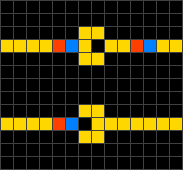
Wireworld, alternatively WireWorld, is a cellular automaton first proposed by Brian Silverman in 1987, as part of his program Phantom Fish Tank. It subsequently became more widely known as a result of an article in the "Computer Recreations" column of Scientific American.[1] Wireworld is particularly suited to simulating transistors, and is Turing-complete.
- ^ Dewdney, A K (January 1990). "Computer recreations: The cellular automata programs that create Wireworld, Rugworld and other diversions". Scientific American. 262 (1): 146–149. doi:10.1038/scientificamerican0190-146. JSTOR 24996654. Retrieved 2 December 2018.